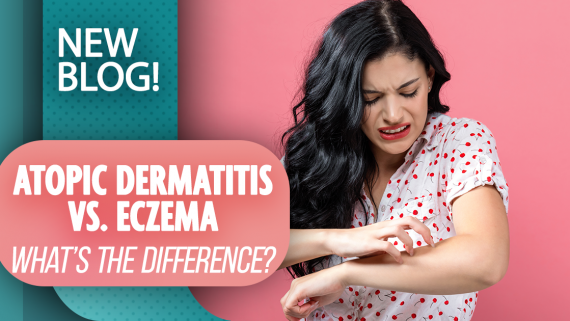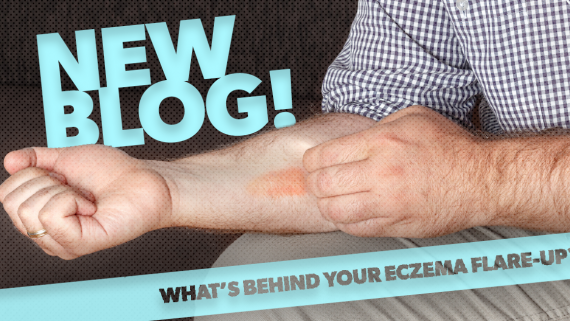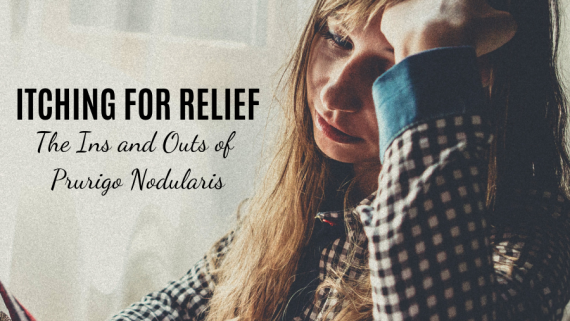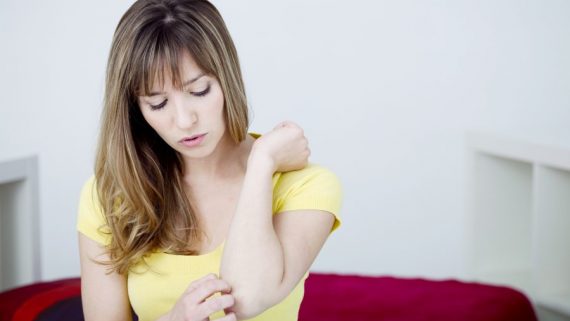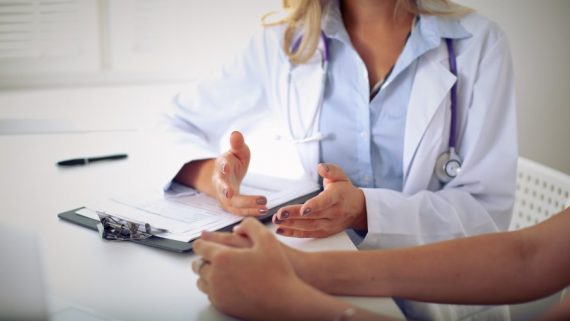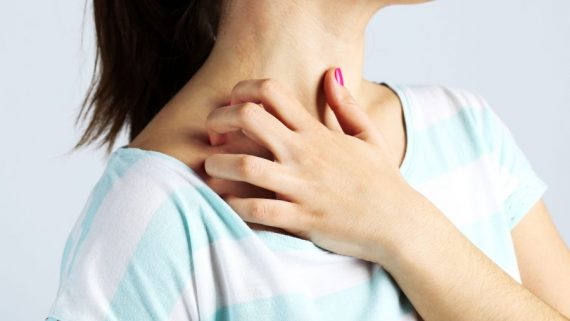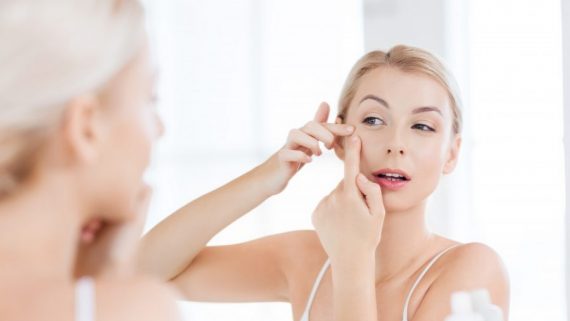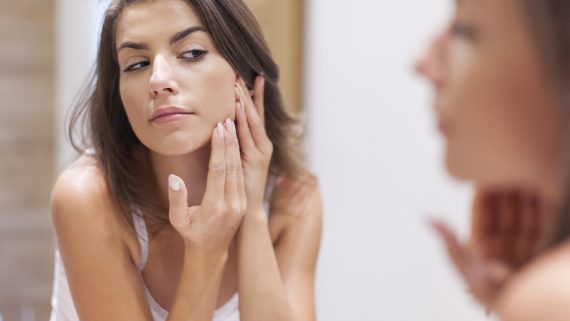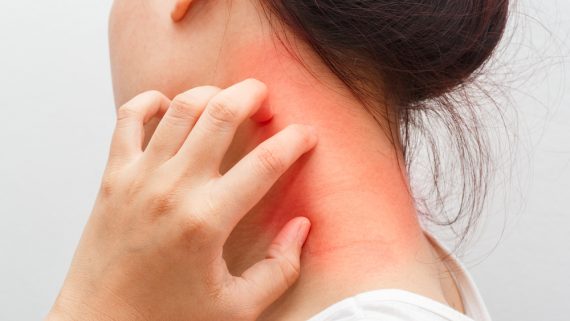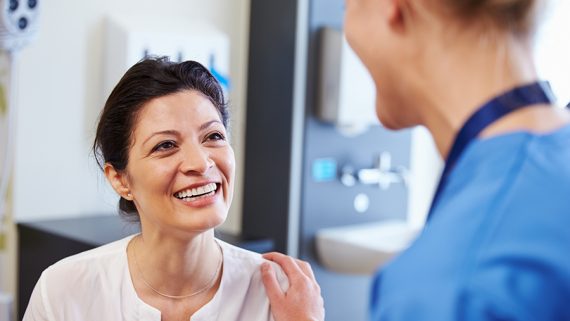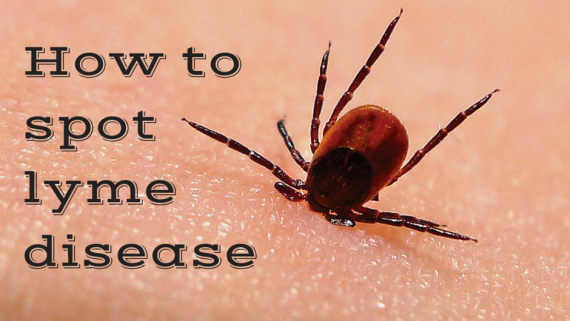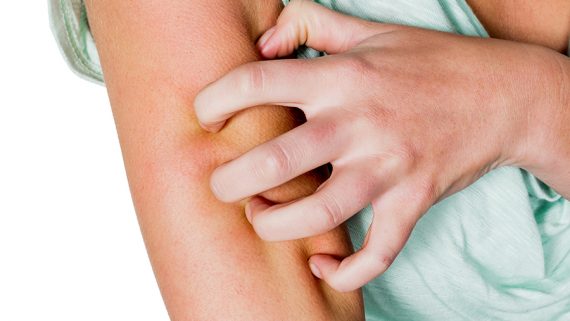UCB recently announced the positive results of the Phase 3 BE READY study, which evaluated the safety and efficacy of bimekizumab in patients with moderate-to-severe chronic plaque psoriasis. These results come from the second of three Phase 3 studies to evaluate the IL-17A and IL-17F inhibitor bimekizumab vs placebo.
These data follow the positive clinical results recently reported from the Phase 3 BE VIVID study, which evaluated the safety and efficacy of bimekizumab vs placebo and ustekinumab, in adults with moderate-to-severe plaque psoriasis. The BE VIVID study met all primary and ranked secondary endpoints showed statistically significant superiority for bimekizumab treatment compared to placebo and ustekinumab in achieving skin clearance and disease improvement at week 16.
Photo: courtesy of The U.S. Food and Drug Administration/Wikipedia.org.
FDA grants fast track designation to lebrikizumab in atopic dermatitis.
Defining Prurigo Nodularis
Prurigo Nodularis (PN) is a skin condition where hard, itchy lumps form on the skin. Prurigo means itch, and nodularis means nodules. The itching caused by PN can be so intense that people often scratch themselves to the point of bleeding. The itching is made worse by sweating, heat, or irritation from clothes. If you have symptoms of PN, or have been diagnosed, read on for more info!
The Cause
The itching itself is what causes the nodules to form. When the skin is scratched repeatedly, it causes injury and the skin then protects itself by creating a thicker layer, which is where the nodules come from. This is called the itch-scratch cycle. Although the cause of PN is not always clear, certain conditions will increase the chances of someone developing PN. Some of those include:
- Psychological conditions
- Reduced liver or kidney function
- Allergies
- Skin diseases such as:
- Eczema
- Bullous Pemphigoid
- Dermatitis Herpetiformis
Diagnosis and Treatment
Excessive scratching also causes nerves to thicken in affected areas and these thicker nerves will then send stronger than normal itching sensations. A skin biopsy is usually performed to determine if PN is the cause of the itching, as a biopsy will show the thickened nerves. Other tests, such as blood, liver, and kidney tests, will also help to identify any underlying cause of the itch.
Treatment of PN is different for every patient and it may take several attempts to find a treatment plan that works for you. Common PN treatments are:
- Corticosteroid Creams are applied to nodules and covered with airtight and waterproof bandages to reduce inflammation.
- Corticosteroid Injections are injected directly into nodules to reduce inflammation.
- Oral Corticosteroids are ingested to reduce inflammation.
- Other Ointments with menthol or phenol cool and soothe itchy skin.
- Capsaicin Cream uses the heat in your body to block nerve messages.
- Oral Antihistamines are ingested antihistamines.
- SSRIs alter serotonin signals in the skin.
Habit reversal therapy is often needed, in addition to medications, to help patients reduce the amount of scratching, which can be very habit-forming. Other treatments can include cryotherapy, photochemotherapy, and immunosuppressants if the common treatments are not effective.
Even with a healthy amount of available treatment options, most people never have a complete resolution of the nodules; therefore, clinical studies to test new treatments are needed to find different and better ways to treat or even cure PN.
ActivMed Practices & Research, Inc. is currently seeking patients interested in helping to evaluate new options that may potentially help treat certain PN symptoms. Qualified candidates who participate will receive study-related care at no cost. Compensation is available for travel. If you or someone you know is suffering from the chronic itch and nodules associated with PN, this study may be a great opportunity. To learn more and to see how you or someone you love may qualify for a PN study, please click HERE.
References:
https://www.aocd.org/page/PrurigoNodularis
https://rarediseases.info.nih.gov/diseases/7480/prurigo-nodularis
Molluscum (muh-luhs-kum) contagiosum (kən-tā-jē-ō-səm) is a skin disease caused by a virus that spreads easily from person to person.
About seven weeks after a person is exposed to the virus, around 10 to 20 small, dome-shaped growths begin to appear on the skin (occasionally, the bumps may take months to appear). They are generally located on the face, armpits, neck, arms, or hands. The bumps are painless, but some can itch. The surface of the bumps initially is smooth and waxy or pearly. They are flesh-colored or pink, although as the body’s immune system begins to fight the virus, the bumps will turn red. Once the bumps are present, you are contagious.
How it Spreads
The virus spreads by either direct skin-to-skin contact with someone who has the virus, or by contact with something infected with the virus.
- Skin-to-Skin Contact – When your skin comes in contact with someone who has the virus, such as when hugging or during contact sports or sexual contact
- Objects Infected with the Virus – Anything infected with the virus, such as towels, clothing or toys. Wrestlers and gymnasts can get it from infected gym mats
Once a person has the virus, they can spread it from one part of their body to another. This is done by scratching or picking the bumps, then touching another uninfected area.
Who Gets It?
Children are most impacted by molluscum contagiosum, although people of any age can be affected. Certain climates, a weakened immune system, and other skin conditions can all increase the risk of getting the virus, as well as the severity of it.
- Climate – The virus thrives in a warm, humid environment
- Weakened Immune System – Those with a weakened immune system, due to AIDS or cancer, for example, are at a higher risk to get the virus, and can develop a more severe form of it (many more bumps)
- Current Skin Conditions – Having atopic dermatitis increases the risk and the severity of the virus (many more bumps)
Treatment
The highly contagious nature of molluscum contagiosum, paired with how it can mimic other skin conditions, makes it important to get a diagnosis from a Board-certified dermatologist. After a person is diagnosed with molluscum contagiosum, the bumps will usually go away on their own without treatment within 12 to18 months, although they can last longer.
Treatment, however, prevents the virus from spreading to other parts of the body. It also prevents spread to other people, which is especially important for people with compromised immune systems.
Stopping the Spread
If you have been diagnosed with molluscum contagiosum, you are the key in preventing its spread to yourself or others. Remember, if the bumps are present, you are contagious.
Here are some ways you can directly prevent the spread of the virus:
- Not sharing items that have been in contact with your skin
- Avoiding sex and other skin-to-skin contact when bumps are present
- Refraining from scratching or picking bumps
- Getting diagnosed and completing any prescribed treatment
At ActivMed Practices & Research, we are committed to not only working with patients to find current treatments that will deliver the most impactful results, but also to working to develop new treatment options through clinical studies.
If you or your child has been diagnosed with molluscum contagiosum, ActivMed Practices & Research currently has an enrolling study for those seeking new treatment options. Qualified volunteers who participate in the study will receive study-related care at no cost. There is also compensation for travel. To learn more and see how you or someone you love may qualify for a research study on molluscum contagiosum, please click HERE.
Reference
https://www.aad.org/public/diseases/contagious-skin-diseases/molluscum-contagiosum
What is the Difference?
Atopic dermatitis and eczema are words that are often used interchangeably. It can be perplexing to think that although there are some similarities between the two conditions, they are different. To start, let’s look at the two individually.
Atopic Dermatitis
Atopic dermatitis is defined by itchy, red rashes that typically appear on the joint areas of the body like elbows, knees, and even the neck. Symptoms can include flaky or scaly patches, dry skin, itching, and sores that may weep. Symptoms appear in “flare ups” and can improve or worsen over time.
Eczema
Eczema is the name of a group of skin conditions that are characterized by itchy and inflamed patches of skin. It is often seen in babies and young children, first appearing on their faces, but it can affect anyone at any age.
Eczema is classified into different types. Some of the most common, along with their symptoms, include:
- Atopic Dermatitis – Flaky or scaly patches, dry skin, itching, and sores that may weep
- Contact Dermatitis – Red rash, itching, burning, stinging, and blisters with liquid
- Seborrheic Dermatitis – Scaly patches, dandruff, red skin, and rashes located in oily areas
The Answer
Once you see the words separated, it’s easy to see why both words are being used interchangeably. Simply put, atopic dermatitis is a form of eczema. If you take away the “atopic” part, we are left with dermatitis. Dermatitis and eczema both are inflammations of the skin, so these two are essentially one and the same.
The prefix “atopic” means that “there is typically a genetic tendency toward allergic disease,” according to The American Academy of Allergy, Asthma and Immunology. The “atopic” part classifies the dermatitis into a category of eczema.
No matter which term you use, it’s not entirely wrong. Eczema and atopic dermatitis are used in the same context so often, most people never know the difference. Now that you do know the differences, you can begin to use the correct terms, and even help others who are not sure!
At ActivMed, we are committed to not only working with patients to find current treatments that will deliver the most impactful results, but also working to develop new treatment options through clinical studies.
If you or someone you love is struggling with atopic dermatitis, ActivMed currently has enrolling studies for those seeking new treatment options. Qualified candidates who participate will receive study-related care at no cost. There is also compensation for travel. To learn more and see how you or someone you love may qualify for a study, please click HERE.
References:
https://www.healthline.com/health/difference-between-eczema-and-dermatitis
https://www.healthline.com/health/eczema
Eczema flare ups can really get under your skin (pun intended). So, learning what can cause a flare up (worsening of symptoms) is a vital step in reducing the number of reoccurrences.
What is Eczema?
Eczema is a group of skin conditions that causes the skin to become red, itchy, and inflamed. The medical term is Atopic Dermatitis. It is estimated that over 30 million Americans suffer from eczema each year.
No one knows what causes eczema to develop for a person. Research has shown that people with eczema tend to have an overactive immune system. Research also shows that some people have a mutation in the gene that produces Filaggrin. Filaggrin is a protein that helps our bodies maintain a healthy protective layer (skin).
Flare Causes:
Below is a list of common items that can cause a flare up. Knowing these potential culprits can help you make different choices in your product purchases and daily activities.
- Temperature- With the summer sun quickly approaching, it is important to note that your skin may not like getting hot and sweaty. Even taking too hot of a bath has been listed as a flare up.
- Hold the Irritants, Please! Anything from the perfumes in hand soap, to the dyes in your laundry detergent can cause your eczema to flare. Paraphenylene-diamine, Formaldehyde, and Cocamidopropyl betaine are ingredients in household cleaners, shampoos, and dyes in certain fabrics that have been linked to eczema flare ups.
- Stress- Stress can affect your body drastically. Increases in stress levels can cause flareups.
Eczema Treatments:
In the event of a flareup, there are many treatment options available from over the counter or prescription topical and oral medications. Consult with your doctor or Dermatologist about your best options.
At ActivMed, we are committed not only to working with patients to find current treatments that will deliver the most impactful results, but also in working to develop new treatment options through clinical studies.
If you or someone you love is struggling with eczema, ActivMed currently has enrolling studies for those seeking new treatment options. Qualified candidates who participate will receive study-related care at no cost and receive compensation for travel. To learn more and see how you or someone you love may qualify for a study, click HERE
References:
https://nationaleczema.org/eczema/
https://nationaleczema.org/eczema/causes-and-triggers-of-eczema/
Alopecia areata is an autoimmune disease that is characterized by patchy hair loss that can affect the scalp and body. According to the National Alopecia Areata Foundation, approximately 6.8 million people in the United States and 147 million worldwide have or will develop alopecia areata at some point in their lives. Alopecia is much more than just hair loss; it can cause severe emotional distress and have a huge impact on the quality of life of those affected. Let’s take a look at what it’s really like to live with alopecia.
Panic, Distress, Denial
When you first feel a bald spot on the back of your head, panic ensues. Grabbing a mirror and seeing a completely bare patch of white scalp can really mess with your head. You immediately begin looking for more bald spots. When you have alopecia, you will inevitably find them. This leads to emotional distress. You may call family members in for a second opinion and to seek comfort. You want to deny that anything could be wrong. You never want to admit that you could have a condition that is causing you to lose your hair.

Reality sets in: Getting to the root of cause
Receiving an alopecia diagnosis can be hard to cope with, but there is a bright side to the situation. People with alopecia areata who have only a few patches of hair loss often experience a spontaneous, full recovery, without the need for treatment. [1] Alopecia is also not contagious and is not due to nerves.
Making Lifestyle Changes Along The Way
Sometimes alopecia is more severe. You may consider wearing a wig to help camouflage the bald spots. While this may bring on feelings of anxiety and self-consciousness, it’s important to remember that most people will never notice. Having confidence and a positive attitude can also help.

HOPE
Clinical trials offer an opportunity to try and help find a cure for conditions like alopecia areata. Physicians at ActivMed Practices & Research, Inc. are working diligently to help find potential new alopecia areata treatment options. If you or someone you love has been diagnosed with alopecia, you may qualify to participate in a currently enrolling research study. Qualified candidates who participate will receive study-related care at no cost and receive compensation for travel. To learn more and see if you may qualify for a study enrolling in Portsmouth, NH CLICK HERE . To learn about our Beverly, MA study CLICK HERE
[1] https://www.medicalnewstoday.com/articles/70956.php
Psoriasis is the most prevalent autoimmune disease in the United States. According to the National Psoriasis Foundation, more than 8 million Americans have psoriasis. The chronic skin condition causes cells to build up rapidly on the surface of the skin and the excess cells form scaly red patches that can be itchy and painful. There are a lot of misconceptions surrounding this uncomfortable skin condition. Let’s clear up a few.
One of the biggest myths about psoriasis is that it’s contagious. Since psoriasis can resemble a rash, many people think they may get the skin disease from someone else. You can’t “catch” psoriasis from someone, even if you make direct contact with their skin.
Another common misunderstanding about psoriasis is that it only affects the skin. The painful effects associated with psoriasis aren’t just cosmetic. People with psoriasis are more likely to struggle with depression and anxiety due to their skin condition, which can have a significant impact on their quality of life. [1]

Many people also think that changing your diet will have an impact on your psoriasis. Your diet does not affect your psoriasis. You may feel better when you are eating healthy, but that’s simply due to healthier eating and has nothing to do with your psoriasis.

There is currently no cure for psoriasis. Many psoriasis sufferers experience periods where their flare-ups are at a minimum, and other periods where their psoriasis is exceptionally bad. While there is no cure, psoriasis symptoms can be treated. Treatments may include prescription medications, light therapies, or injected medications to name a few. However, these treatments don’t work for everyone.
Physicians at ActivMed Practices & Research, INC are currently enrolling for studies evaluating potential new psoriasis treatment options. Qualified candidates who participate will receive study-related care at no cost and receive compensation for travel. To learn more and see how you or someone you love may qualify for a study, click HERE.
[1] https://www.psoriasis.org/life-with-psoriasis/depression
Prurigo nodularis, or PN, is a skin disease that causes hard bumps, or nodules to form on the skin. These nodules are extremely itchy and can itch constantly. Many people scratch themselves to the point of pain or even bleeding due to the intense itch. Unfortunately, itching the bumps can cause more of them to appear, escalating the vicious cycle.

What causes prurigo nodularis?
While the exact cause of PN is unknown, certain risk factors may make you more prone to developing PN. Some of these include:
- A history of skin conditions that cause itching, such as eczema
- Reduced liver and kidney function
- Type 2 diabetes
- HIV/immunodeficiency
- Some psychological conditions
What exactly do the nodules look like?
The nodules can vary in size. You may have some that are very small and some that are rather large. They typically have a dry, rough top and typically appear on areas like the arms, shoulders, and legs. You may notice a few nodules, or a few hundred.
Is prurigo nodularis genetic?
Prurigo nodularis is not believed to be an inherited disease. If one of your parents has PN, this does not mean that you will develop it. However, since the development of PN is sometimes associated with having other health problems or skin diseases, you may notice a family history associated with those skin conditions.

How is prurigo nodularis treated?
While some treatments to reduce itchiness are available, they don’t work for everyone. Many people with PN may have to try several different treatments without receiving much relief due to the intense itch that comes with PN. Fortunately, if you have prurigo nodularis, you may be eligible for currently enrolling research studies to help find potential new PN treatment options.
Physicians at ActivMed Practices & Research, INC are seeking adults with PN for local enrolling research studies. Qualified candidates who participate will receive study-related care at no cost and receive compensation for travel. CLICK HERE to learn more and see if you or a loved one may qualify for studies enrolling in Beverly, MA or CLICK HERE to learn more about PN studies enrolling in Portsmouth, NH.
Atopic dermatitis, or eczema as it’s more commonly known, is a frustrating condition that affects more than 35 million Americans. Symptoms tend to present as patches of skin becoming red and itchy, with areas of oozing or swelling. It most commonly appears on the face, backs of the knees, insides of the elbows, hands and wrists. Eczema is long-lasting and tends to ‘flare-up’ periodically. While most common in children, Eczema can affect anyone at any age. By knowing some common eczema triggers, it can help you to manage flares and prevent new outbreaks.
- Stress: Stress is one of the most common eczema triggers. While it’s nearly impossible to remove all of the stress from our lives, trying to keep our stress levels at a minimum can help with flares.

- Temperature Extremes: Too hot or too cold is not ideal for those with eczema. Excessive sweating is an eczema trigger for many people, while extreme cold can cause the skin to become too dry. Aim for a comfortable environment with humidity levels of 45-55 percent.
- Cosmetics: Cosmetics tend to have fragrances or preservatives in them that can be irritating to eczema sufferers. Look for “fragrance-free” products and do a patch test before using them to check for irritation.
- Get to know your fabrics: Cotton is the best option when it comes to eczema sufferers. Wool, synthetics, and other rough materials could irritate skin and trigger a flare.

- Laundry Detergents: Harsh ingredients in many detergents can irritate skin. Opting for a fragrance-free, neutral pH detergent is a good choice.
- Diet: Food allergies can sometimes trigger eczema symptoms, so if you start to notice symptoms after eating a particular food, it might be time to see your doctor.While there’s currently no cure for eczema, the condition can be better managed by knowing your personal triggers and avoiding them to prevent flare-ups.
If you or someone you love is struggling with eczema, ActivMed currently has enrolling studies for those seeking new treatment options. Qualified candidates who participate will receive study-related care at no cost and receive compensation for travel. To learn more and see how you or someone you love may qualify for a study, click HERE.
No two people are born completely identical. Even in the case of twins, personalities, preferences, and even minute physical differences, makes each person a unique individual. In the same way, the appearance and symptoms of skin conditions vary from person to person.
Eczema, psoriasis and prurigo nodularis (PN) are three common diagnoses that have no known cure, yet they affect the lives of millions across the globe. The symptoms of each disease are remarkably similar, and yet they each maintain distinct differences, making general treatment options difficult to prescribe. In celebration of Healthy Skin Month, here is a brief explanation of these three diseases, and what symptoms they each manifest.
Eczema
Eczema is an umbrella term used to describe a condition in which the skin becomes rough, inflamed, and causes itching and bleeding. Sometimes also referred to as Atopic Dermatitis, eczema is a hypersensitive allergic response in which the immune system attacks an unspecified stimulant inside or outside the body. Symptoms include:
- Dry skin
- Redness
- Itching/Bleeding
- Skin cracking
According to the National Eczema Association, while all types of eczema can cause redness and itching, specific types of eczema, such as Nummular eczema, can leave open, crusted or “weeping” sores. Fortunately, eczema does tend to appear in “flares”, and can subside over time.
Psoriasis
Similar to eczema, psoriasis causes itching, dry patches on the surface of the skin. The primary difference is that psoriasis is a chronic autoimmune condition that results in the production of too many skin cells. These skin cells cause thick, scaly patches to form, which can limit flexibility and cause pain. Other symptoms of psoriasis include:
- Red patches covered in thick, silvery scales
- Itching, burning, soreness
- Swollen and stiff joints
Prurigo Nodularis (PN)
Unlike eczema and psoriasis, PN is an intensely itchy skin condition that is hypothesized to be primarily caused by a thickening of nerve endings that sends a strong itching impulse to the brain. When repeatedly scratched, these nerve endings develop thick, hard nodules on the surface of the skin that can scar. Patients diagnosed with PN often find themselves scratching until pain or bleeding occurs, even while asleep. Similar to the effects of poison ivy, the more scratching that occurs, the more the nodules form and spread.
Treatment and Research
Unfortunately, there is no known cure for these conditions. Physicians at ActivMed are looking to change this reality by continually seeking new treatment options for patients diagnosed with eczema, psoriasis and PN. Those who qualify and participate in a clinical study will see a dermatologist at no cost, and receive compensation for travel. If you or someone you know has experienced chronic, itchy skin conditions, you may be eligible to participate! To learn more on how you can be involved, CLICK HERE.
August brings the arrival of Psoriasis Awareness Month. A chronic, systemic disease of the immune system, psoriasis most often appears on the skin as raised, itchy red patches. Living with psoriasis can seem like an uphill battle, but it’s important to know that if you’re struggling with psoriasis, you’re not alone.

The National Psoriasis Foundation reports that as many as 7.5 million American have psoriasis. Included in that number are people like you and me, but also people that many look up to, even idolize, like Kim Kardashian and Cyndi Lauper.
Cyndi Lauper is an icon is the music world, known for many hits that are still popular today. She revealed to PEOPLE magazine her psoriasis struggle that began back in 2010 with irritation on her scalp that she simply chalked up to bad hair dye.

Unfortunately, her scalp irritation then turned into an entire body rash complete with itchy, scaly skin over the next couple of years. Her immune system suffered as well. It took a toll physically and emotionally, and affected her ability to perform. Now, Lauper has found a treatment plan that helps her to manage her symptoms. She also avoids eating and drinking things that are associated with inflammation.
Psoriasis is the most prevalent autoimmune disease in the U.S. and not every treatment is a good fit for each person struggling to mange systems. If you or someone you love has been diagnosed with psoriasis, ActivMed is currently enrolling studies for potential new treatment options at the Portsmouth, NH and Beverly, MA sites. Qualified candidates who participate will receive study-related care at no cost and receive compensation for travel. To learn more and see if you qualify for a study at our Portsmouth, NH location, CLICK HERE. For our Beverly, MA location, CLICK HERE.
Psoriasis is a disease that causes red, scaly patches to appear on the skin. It typically occurs on places like knees, scalp, and elbows, but can really show up anywhere. The uncomfortable rash can sometimes itch or burn. Psoriasis doesn’t stop at the skin. While the physical struggles associated with psoriasis can be considerable, the disease can also affect your mental and emotional health.
According to the National Psoriasis Foundation, people with psoriasis are more likely to suffer from depression. It’s even been said that depression is the number one comorbidity of psoriasis. Why is that? Some doctors believe that biological changes that cause psoriasis may play a part. The stigma associated with visible psoriasis can also make people depressed.
For most people with psoriasis, the red, scaly patches can be embarrassing. Many people will opt to wear long sleeves to conceal their psoriasis, and in the summer this is especially hard as heat and sweat can make psoriasis worse. While you may be anxious about showing too much skin, you don’t want to allow yourself to become overheated.
Many people with psoriasis will notice that their symptoms seem to improve during the summer months. While you may notice a reduction in your skin patches with added sunlight, remember to limit your sun exposure! Getting burnt could trigger a flare.
While psoriasis is one of the most common skin diseases, there is no cure. If you or someone you love is struggling to manage psoriasis symptoms, ActivMed is currently enrolling in studies for those seeking new treatment options. Qualified candidates who participate will receive study-related care at no cost and receive compensation for travel. To learn more and see how you or someone you love may qualify for a study at our Beverly location click HERE or at our Portsmouth site, click HERE.
Atopic dermatitis, also known as eczema, is a condition that causes skin to be red and itchy. The itching can be so uncomfortable it can get in the way of daily activities and cause problems when it comes to sleeping. It most commonly appears on the face, backs of the knees, insides of the elbows, hands and scalp.
The National Eczema Association estimates that over 31 million people in the U.S. have some form of eczema. Unfortunately, there are a lot of misconceptions surrounding this common skin condition. Here are just a few to help you understand eczema a little bit better.
- Eczema is contagious. This is a big one we hear all the time. You can’t ‘catch’ eczema from someone who has the disease and you can’t give it to someone by touching them if you have it.
- Eczema and acne are the same. This is false. The small bumps that eczema can cause are not acne.
- Eczema is caused by bad hygiene. The cause of the disease has nothing to do with personal hygiene. According to WebMD, doctors think eczema is caused by a combination of factors including combination of environmental, genetic and immune system factors.
- Eczema is caused by stress. While stress can trigger eczema and make it worse, stress does not cause eczema.

- Eczema can be cured. While there’s currently no cure for eczema, the condition can be better managed by knowing your personal triggers and making a treatment plan based upon that information.
Researchers at ActivMed are currently studying potential new eczema treatment options. If you or someone you love is struggling to manage eczema symptoms, you may be eligible to participate in a research study. Qualified participants are closely evaluated by board-certified dermatologists and other medical professionals, and may even gain access to new treatments before they are available to the general public. Compensation is also available for travel expenses. To learn more, click HERE.
Acne is a skin condition that occurs when hair follicles become clogged with oil and dead skin cells. Pimples, blackheads, and bumps on the face, chest, and back are all typical of acne. Acne is most common in teenagers and young adults, but can present at any age. Dealing with acne can be incredibly frustrating and embarrassing. You’ve probably heard an overwhelming number of tips and tricks for getting clear skin. Let’s talk about which of those tips hold some truth and which are simply myths.
Fact: If you’re prone to acne breakouts, excessive touching of your face can trigger breakouts and exacerbate acne symptoms. Every time you touch your face you’re introducing whatever germs your hands have come in contact with to your skin, so remember – hands off!
Myth: Don’t wear sunscreen; it will trigger a breakout. It’s all about choosing the right sunscreen. If you’re acne prone, steer clear of chemical sunscreens and opt for physical sunscreens which work by sitting on top of the skin to deflect UV rays. Physical blockers are made of zinc oxide and titanium dioxide and are great choices for people with sensitive or reactive skin.
Fact: Popping pimples does more harm than good. We think that popping a pimple will make it go away more quickly when in fact squeezing or picking can push bacteria further into the skin and lead to scarring.
Myth: Eating chocolate gives you acne. The role of chocolate and how it affects acne remains somewhat controversial. While studies don’t show that chocolate itself worsens acne, some studies have indicated milk products may influence acne because of the hormones and bacteria present in milk.
Fact: Tanning is not the answer. While evidence exists to show that sun exposure can improve acne symptoms, UV exposure is associated with a number of other dangerous drawbacks such as accelerated skin aging and an increased risk for skin cancer.
Myth: Acne is contagious. Unlike most bacterial infections, it is not contagious and cannot be spread from person to person.
While dealing with acne can seem like an uphill battle, being familiar with some important key facts may help when it comes to managing this condition. If you or someone you love is struggling with acne, ActivMed is currently enrolling in studies for those seeking new treatment options. Qualified candidates who participate will receive study-related care at no cost and receive compensation for travel. To learn more and see how you or someone you love may qualify for a study at our Portsmouth, NH location CLICK HERE or at our Beverly, MA location by CLICKING HERE.
Our blog provides general information about health and related subjects. This content should not be interpreted as medical advice.
Rosacea is a skin condition associated with facial redness. Small, visible blood vessels are also common along with swollen red bumps, which can cause rosacea to be mistaken for acne. Rosacea is a chronic disease that affects more than 16 million Americans. It is found most commonly in fair-skinned, middle-aged women.
Unfortunately, managing rosacea throughout the winter months can be quite the feat. For many people suffering with rosacea, symptoms seem to worsen during the winter months. So what is the reason for increased rosacea symptoms in the winter months? Cold, dry air and gusty winds are a common trigger for many rosacea sufferers.
Some other examples of common rosacea triggers include:
• Sun exposure- It is a common misconception that during the winter months sunscreen is unnecessary, when in fact the UV rays reflect from the snow making you susceptible to damage from the sun itself, and its reflection.
• Indoor Heating- The warm, dry heat that indoor heating systems push out can trigger a flare.
• Cooking/Baking- Getting overheated while cooking or baking can be the source of a flare-up. Keeping a cool towel in the kitchen can help.
• Spicy foods & hot beverages- Eating spicy foods and drinking hot beverages like coffee or tea can both prompt a rosacea flare.
• Cozying up to the fire- While the fireplace may be inviting, sitting too close could trigger a flare.
Taking steps to avoid triggers is key when it comes to managing rosacea. Keeping stress under control and making smart, practical choices when it comes to your environment will put you on the path to successfully controlling rosacea symptoms.
If you or someone you love is struggling with rosacea, ActivMed is currently enrolling in studies for those seeking new treatment options. Qualified candidates who participate will receive study-related care at no cost and receive compensation for travel. To learn more and see how you or someone you love may qualify for a study, click HERE.
Nutrition articles stress the importance of following a strict diet in order to control bouts of acne, but is this really true? Many resources attribute refined carbohydrates, dairy, and saturated fats to acne. The thought is that Americans have become accustomed to a diet lacking low glycemic index foods (ie. processed foods), which in turn spikes insulin levels and causes an increase in sebum production. This sebum production can then clog pores often on the face, chest, and back, resulting in acne.
In 2013, a research study published in the American Academy of Dermatology showed a strong correlation between acne and diet. The article highlighted research based studies that primarily focused on glycemic index and blood sugar. In particular, a study of Australian males who followed a strict low gly cemic diet experienced significant improvement in the severity of their acne after following a diet of low glycemic index foods. The results were not surprising and seemed to follow established stereotypes. However, they also had significant weight loss during the study. Did the diet itself cause the improvement in acne, or was it the weight loss? Or was it something else altogether?
cemic diet experienced significant improvement in the severity of their acne after following a diet of low glycemic index foods. The results were not surprising and seemed to follow established stereotypes. However, they also had significant weight loss during the study. Did the diet itself cause the improvement in acne, or was it the weight loss? Or was it something else altogether?
It is hard to pin point what is the actual cause of acne because is seems to be a culmination of factors including genetics, food production, and food choices. In addition, with this particular study, there could be other differences besides diet that could contribute to the differences in acne results. While it is true that a diet rich in fruits, vegetables and lean meats is an effective way to maintain a healthy body, it may or may not be the case for acne.
So is acne really affected by diet? There are certainly many studies that show a link. However, more studies are needed to figure that out true cause and control for more environmental and genetic factors. In the meantime, it can’t hurt to get the other proven nutritional benefits from eating a healthy diet!
Click here for more information about our acne studies
ActivMed is determined to help find a helpful medication to treat different severities of acne. We are currently enrolling for several acne related studies. Please feel free to call for more information at any time! 603-319-8863
Source: American Academy of Dermatology
Authored by: Samantha Lemelin, RA
Medically reviewed by: Marc Shay, MD
According to the American Academy of Dermatology, Atopic Dermatitis is a common skin disease in children and adults. Atopic Dermatitis has been given a few names, some of which may sound more familiar. Other names for Atopic Dermatitis include:
- Eczema (the name most people use)
- Dermatitis
- Atopic eczema
This skin disease is often characterized by very dry and itchy skin. If these areas on the skin are scratched, they will appear red and irritated, and infection can likely occur. These symptoms may come and go or there may be a persistent rash that, over time, could lead to tough and thicker skin areas. The American Academy of Dermatology, also states that Atopic Dermatitis appears differently in infants, children, and adults.
| Infants (Newborn- 2 years old) | Children (2 years old- puberty) | Adults |
| Rash that appears mostly on the scalp and face- especially on the cheeks (Rarely appears in diaper area) | Rash that appears mostly in the creases (I.e. elbows, knees) and also neck, wrists, and ankles. | Rash that appears in the creases of the elbows or knees and nape of the neck, and covers most of the body. |
| Signs of Atopic Dermatitis include trouble sleeping, rubbing against bedding or carpeting, or possibly skin infections. | Signs include the rash noted above, and itchy, scaly patches where the rash appeared. Thickened skin patches can itch even when Atopic Dermatitis is not flaring up. | Can be especially bad around the eyes, causes very dry, non-stop itchy skin. Also appears scalier in affected areas compared to infants and children. |
Around the world, between 10% to 20% of children are affected by Atopic Dermatitis, and about 1% to 3% of adults have Atopic Dermatitis. Anybody can get this disease, regardless of their skin pigmentation. Most of the people with atopic dermatitis are diagnosed before they are 5 years old (roughly 90% of people), and it is rare for atopic dermatitis to be initially diagnosed as an adult.
Some of the common factors that seem to increase a person’s likelihood of getting Atopic Dermatitis include:
- Family members that have Atopic Dermatitis, asthma, or hay fever
- Where someone lives (developed countries and colder climates are more at risk)
- Females are slightly more likely to develop Atopic Dermatitis
- The mother’s age at their child’s birth (If the mother gives birth later in life, the child is more likely to develop Atopic Dermatitis)
- Social Class (Atopic Dermatitis is more common in higher social classes)
Researchers are still studying what causes Atopic Dermatitis, but it is important to know that it is not contagious, and the disease usually runs in families. Across the country, there are multiple studies being conducted to aid in the treatment of Atopic Dermatitis, as well as to find out more about the disease in general.
If you are interested in joining a clinical trial, please contact us today!
ActivMed Website: https://allcutisresdev.wpengine.com/
ActivMed Phone: 603-319-8863
Authored by: Kendra Thibeault
Medically Reviewed by: Abel Jarell, MD
Sources:
American Academy of Dermatology
Clinical trials are research studies that utilize human volunteers, as individuals or in groups, to help researchers evaluate health-related interventions to evaluate the effects on health-related outcomes. Subjects are chosen from diverse groups of people reflecting both genders at variety of ages and ethnicities unless the study pertains to one specific type or group. The studies are divided into Phases according to which stage of development the health-related interventions being tested are established.
Phase 0 studies usually only involve a small number of people and they only have a small dose of a drug. Researchers are trying to find out if the drug reaches the root cause of the condition and how the drug interacts with the body.
Phase I studies a re generally small, with just a few patients. Once testing indicates a n
re generally small, with just a few patients. Once testing indicates a n
ew treatment might help treat its target condition, phase 1 trials are done to determine what dosage of the drug is safe to use, what, if any side effects are generated, how the body copes with the drug and If the treatment is effective in treating the condition.
Phase II trials are designed to determine if the new treatment works well enough to test in a larger phase III trial, whether or not there are inherent side effects and a method to deal with them and to ascertain the most suitable dose to use for the best, safest results.
Phase III trials may compare new treatments with the currently recommended treatment to see how a completely new treatment compares with the standard treatment, to determine different doses or ways of giving current treatments. These trials will generally involve a larger number of subjects than phase I or II as differences in success rates may be small and more patients are required to show the difference.
Phase IV trials are done after a drug proven effective and is granted approval. Phase IV trials are conducted to learn more about any side effects and safety of the drug for general use. This phase is also used to determine how well the drug works in larger populations and to explore the drugs longer term risks and benefits.
WHY DO SUBJECTS GET INVOLVED IN CLINICAL STUDIES?
People volunteer to participate as subjects in clinical studies for myriad reasons. Some subjects that suffer the conditions for which a new treatment is being studied become involved to have access to the latest treatments available and, hopefully; to help hasten the development of a new tre atment that will benefit them. Others want to play a more active role in their own healthcare and to understand their ailment and methods of treatment more completely.
atment that will benefit them. Others want to play a more active role in their own healthcare and to understand their ailment and methods of treatment more completely.
Most study subjects, especially healthy participants volunteer for more altruistic reasons such as helping to advance medical science to the benefit of everyone, to ease suffering and to offer hope to those suffering chronic conditions. Some subjects state that they want to “pay forward” the benefits they have experienced due to the efforts of past volunteers who have helped in the development of medications and treatments that have had a positive influence on their lives.
Whatever the reason; volunteering as a clinical study subject can have a long lasting impact on the advancement of medicine and the well-being of future generations. The next time you take a medication to ease, treat or even heal an ailment…remember… the relief you experience is partially due to the efforts and generosity of clinical study volunteers.
Authored by: Jack Beaton, RA, CMA
Medically Reviewed by: Marc Shay, MD
The weather is getting warmer and everyone wants to get outside after the long, cold New England winter. We want to play with our kids, hike with our dogs, and start getting a head start on all of our yard work. Unfortunately, we all keep hearing more and more about the prevalence of lyme disease, especially in the Northeast, and the fear of going outside and enjoying yourself gets worse and worse with every story. It doesn’t help that the disease is very difficult to diagnose, especially in its early stages when it is more easily treated.
Lyme disease is an illness that is transmitted from a tick bite when it transfers the bacterium Borrelia burgdorferi. If it is diagnosed early, it can be cured pretty quickly with a round of antibiotics. However, without early treatment, it can turn into a very serious illness involving the joints, heart, and nervous system. It can still be treated at this point, but may need larger doses or intravenous antibiotics. In addition, some people continue to have persistent fatigue and achiness after they have finished their treatment, which can take months to go away.
So what can you do if you are going to have a long day outside to make sure you have a better chance preventing a tick bite?
Wear more clothes!
Wearing long sleeves and tightly woven clothing can greatly help in preventing a tick from getting to the food source: your skin. In addition, you can wear long pants and tuck them into your socks for added protection. Light colors can also be helpful in being able to see the ticks on your clothing.
Use a repellant.
Repellants with DEET are known to be effective in repelling ticks. However, use in moderation and with caution as they are also shown to have some side effects.
Always do a “tick check” after a day outside, especially in wooded or grassland areas.
Have you heard the country song, “I want to check you for ticks?”
Toss your clothes in the dryer.
If you immediately remove your clothing after coming indoors and put them in the dryer, the heat will kill the ticks. That way they aren’t wandering around the house looking for their next meal!
Take a shower.
This can help wash those pesky buggers away before they can chomp down.
If you find a tick, remove immediately.
Since it takes a bit for the bacterium to be transmitted in the blood, you may avoid infection if you remove an infected tick early enough. Stay tuned for another blog post coming up regarding tips for tick removal.
You did all you could, but you still suspect you may have been infected, what are the early signs?
The bull’s eye rash
Erythema migrans, or more commonly known as the “bull’s eye rash,” occurs in 70%-80% of cases. It usually starts as a small red spot at the site of the tick bite and expands over a period of days or weeks. It can sometimes end up resembling a bull’s eye with a clear center and a red circle around it, hence the name. The rash can vary greatly in both its size and the length of time a person has it. It can be as small as a dime and as large as an entire person’s ba ck. It can range from a few days to a few weeks.
ck. It can range from a few days to a few weeks.
Other early symptoms:
- Fever
- Headache
- Stiff neck
- Body aches
- Fatigue
If you suspect that you may have a tick bite rash, call your doctor immediately for treatment.
Have a bull’s eye rash? To learn more about clinical research exploring early detection of Lyme disease after a tick bite and other topics, click here or call us directly at 603-319-8863.
Authored by: Ashley Skukalek, CCRC
Medically Reviewed by Marc Shay, MD
Psoriasis is a common skin disease, which causes cells to rapidly build up on the skins surface. While Psoriasis symptoms can get better, there is no cure and usually symptoms will come back at some point or another.
In ancient times, urine was used to treat psoriasis. Thankfully nowadays there new treatments like topical creams, light therapy (also called phototherapy), and oral and injectable medications.
Recently damaged skin, such as areas that have recently been bitten by an animal, recently been tattooed, or been exposed to any other damaging act, are more likely to develop psoriasis.
One of the most common misconceptions about the disease is that it is contagious. This misbelief can cause people with psoriasis to feel uncomfortable in their own skin (literally). They may even be ashamed to show their skin while they have a flare up.
Psoriasis can develop anywhere on the body, but the most common places for it to show are elbows, scalp, and knees. These patches can be very uncomfortable, itchy and dry.
The best thing for people with Psoriasis to do is to seek treatment when they have flare ups and follow their treatment plans.
You can find out more about the psoriasis research studies now enrolling at ActivMed’s Newington NH and Beverly MA sites here!
Written by Tori Stubbs






